Spätzle
Spätzle [ˈʃpɛtslə] (![]()
| Place of origin | Germany, Central Europe |
|---|---|
| Main ingredients | Egg noodles (flour, eggs, salt, water) |
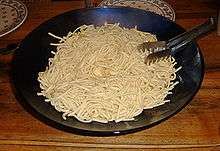
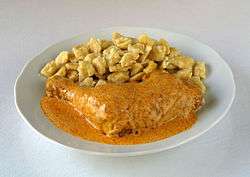
Etymology
Spätzle is the Swabian diminutive of sparrow. Before the use of mechanical devices, the pasta was shaped by hand or with a spoon and the results resembled Spatzen (plural of Spatz, meaning sparrows, sparrow is Spatz or Sperling in German; Spätzle is the diminutive of Spatz, unchanged in plural).
Knöpfle means "small buttons" and describes the compact, round form of the pasta. In everyday language usage, the two names refer to the same product made from the same dough and are interchangeable.[1] There is no clear distinction between the way the two names are used and usage varies from one region to another.
History
The geographic origin of spätzle is not precisely known; various regions claim to be the originators of the pasta.
The tradition of making "Spätzle" can be traced back to the 18th century, although medieval illustrations are believed to place the pasta at an even earlier date.[2] In 1725, Rosino Lentilio, a councillor and personal physician from Württemberg, concluded that "Knöpflein" and "Spazen" were "all the things that are made from flour".[1] Spelt was grown widely in the Swabian-Alemannic area at the time. The cereal grows on poor soils and was very popular in the region, which was home to small farmers and characterised by poverty. As spelt flour contains high levels of gluten protein and the dough could therefore be made in times of hardship without the need for eggs, "Schwäbische Spätzle"/"Schwäbische Knöpfle" were mainly made from spelt.[1] The product achieved fame in the Münsinger Alb upland area. As industrialisation began and prosperity increased, the pasta went from being an ordinary, everyday food item to a culinary specialty eaten on feast days. In a description of a Swabian farmers’ village written in 1937, "spätzle" are described as a festive food. The great importance of "Schwäbische Spätzle"/"Schwäbische Knöpfle" in Swabian cooking can be seen, inter alia, from the 1827 novel Die Geschichte von den Sieben Schwaben, according to which the custom in Swabia is "to eat five times a day, five times soup, twice with 'Knöpfle' or 'Spätzle'".[1]
Today, Spätzle are largely considered a "Swabian speciality"[3] and are generally associated with the German state of Baden-Württemberg. In France they are associated with Alsace and Moselle. The total estimated annual commercial production of spätzle in Germany is approximately 40,000 tons.[4] Pre-made spätzle are also available internationally.
Protected designation of origin
Since March 2012, Swabian Spätzle and Swabian Knöpfle have been awarded the EU quality seal for "Protected Geographical Indications (PGI)" and are protected throughout Europe as a regional specialty.[5] In order to be able to bear this sign, one of the production stages of the product must have taken place in the respectively defined region of origin.
Preparation
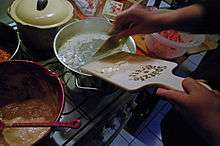
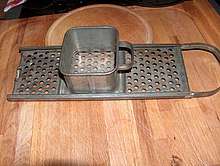
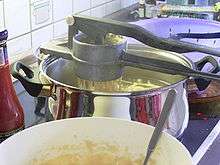
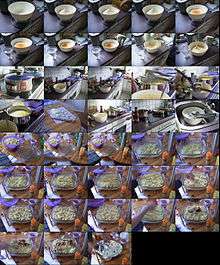
Spätzle dough typically consists of few ingredients, principally eggs, flour, and salt. The Swabian rule-of-thumb is to use one more egg than the number of persons who will eat the spätzle. Often, water is added to produce a thinner dough.[6] The flour traditionally used for spätzle is a coarse type known as Dunstmehl, similar to US "first clear" or Czech hrubá type, known in the UK as semolina flour or pasta flour from durum wheat with a high yellow semolina content. This gives a chewier texture but can produce a dough too crumbly for scraping if no water is added, particularly when cutting short on eggs for dietary reasons. If fine ("all-purpose") flour and the full complement of eggs are used, all fat and moisture in the dough is derived from these, and water is rarely necessary.
Traditionally, spätzle are made by scraping long, thin strips of dough off a wooden (sometimes wet) chopping board (spätzlebrett) into boiling salted water where they cook until they rise to the surface. Altogether, the dough should thus be as viscous as to slowly flow apart if cut into strips with a knife, yet hold the initial shape for some seconds. If dropped into boiling water, the albumen will congeal quickly in the boiling water, while the yolk will keep the dough succulent. After the pasta has become firm, they are skimmed and put aside.
Since this can be a cumbersome way to prepare spätzle, several devices were invented to facilitate cooking that resemble a strainer or colander, potato ricer (spätzlepresse), food mill or coarse grater (spätzlehobel). As with scraped spätzle, the dough drops into the boiling water. Those instruments that use muscle pressure in addition to gravity can be used with a firmer dough; that for a spätzlehobel should be as "runny" as the one for scraping.
Dough varieties
For certain specialty dishes, the dough may be enriched with minced pork liver (resulting in Leberspätzle), spinach, or finely grated cheese.
Dishes
Spätzle typically accompany meat dishes prepared with an abundant sauce or gravy, such as Zwiebelrostbraten, Sauerbraten or Rouladen. In Hungary spätzle often are used in soup. Spätzle also are used as a primary ingredient in dishes including:
Savory
- Linsen, Spätzle und Saitenwürstle: Spätzle with lentils and fine-skinned, frankfurter-style sausages
- Käsespätzle: Spätzle mixed with grated cheese (typically Emmenthaler) and fried onion
- Gaisburger Marsch: Traditional Swabian beef stew
- Krautspätzle: Spätzle mixed with sauerkraut, onion, butter and spices such as marjoram and/or caraway
- Spätzle mit Käse überbacken – Spätzle mixed with cheese and topped with paprika
- Leberspätzle: Spätzle mixed with ground liver, often served as a soup with a clear broth
- Spinatspatzeln (Tyrolean dialect): Spätzle which also contain spinach as one of the ingredients; a speciality of Trentino-Alto Adige/Südtirol
Sweet
- Kirschspätzle: Spätzle mixed with fresh cherries, dressed with clarified, browned butter, sugar and cinnamon and/or nutmeg. In the Allgäu, this is served as a one-dish supper in late summer.
- Apfelspätzle: Spätzle with grated apples in the dough, dressed with clarified, browned butter, sugar, and cinnamon. In the Allgäu, this is served as a one-dish supper in autumn.
Gallery
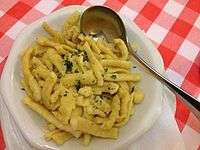 Spätzle
Spätzle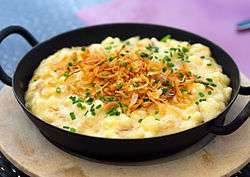 Käsespätzle (cheese Spätzle), Spaetzle with cheese and onions
Käsespätzle (cheese Spätzle), Spaetzle with cheese and onions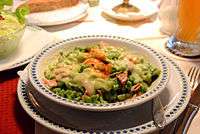 Spinatspatzeln
Spinatspatzeln
See also
- Schupfnudel
- Klöße, larger dumplings
- Halušky, eastern European equivalent of spätzle
- Gnocchi, similar Italian pasta/dumplings
- Passatelli, similar Italian pasta made with bread crumbs in place of flour
References
- "Publication of an application pursuant to Article 6(2) of Council Regulation (EC) No 510/2006 on the protection of geographical indications and designations of origin for agricultural products and foodstuffs". eur-lex.europa.eu. Retrieved 27 December 2018.
- German Embassy London - Spätzle
- Spezialitäten aus Baden-Württemberg (German)
- Spätzle a la Suppenküche
- "Registration as a protected geographical indication". Official Journal of the European Union L69/3. Retrieved 27 December 2018.
- Basic-Recipes.com - Spätzle Archived 2007-11-14 at the Wayback Machine
External links
| Wikimedia Commons has media related to Spaetzle. |